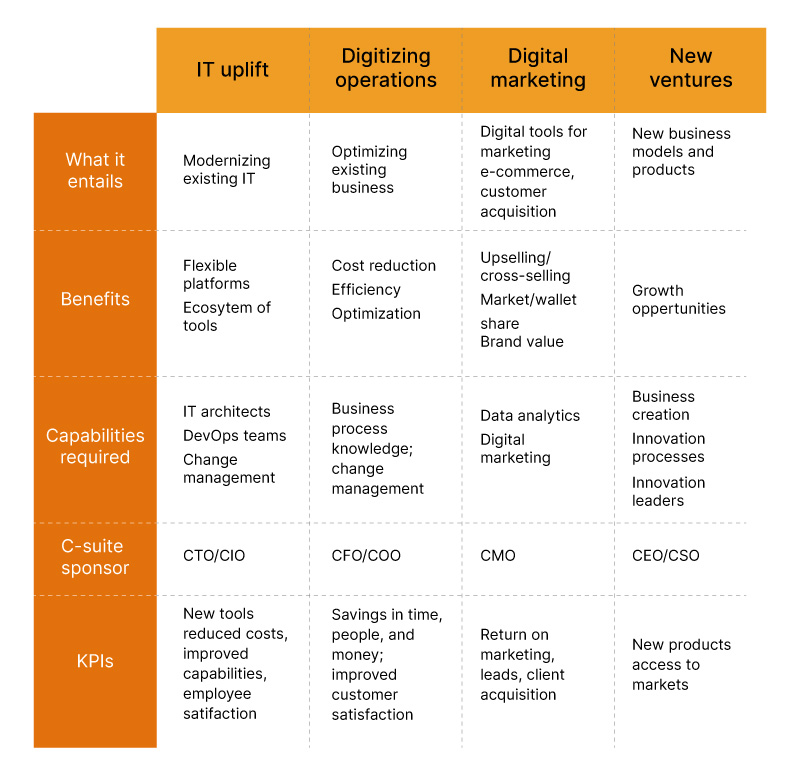Every business is on a digital transformation journey, though they may not realize it. In its simplest form, digital transformation is the process of using technology to create new or improved business processes. However, undertaking a total digital transformation project for your business can be daunting, as it requires a complete rethinking of how a business operates. The good news is that there are plenty of resources available to help businesses make the transition. From consultants and software providers to online articles and webinars, there is no shortage of advice for companies embarking on a digital transformation journey. So what does a digital transformation journey actually mean? And how to start the digital transformation with it?
Here are some essential steps to make sure your journey is a success. By following these guidelines, you’ll be able to improve your business and stay ahead of the curve in today’s constantly-changing technological landscape.
Table of Contents
Why Should You Embark on a Digital Transformation Journey?
There are many reasons why your business should embark on a digital transformation journey. First and foremost, it will help you keep up with the competition. In today’s business world, companies that don’t embrace digital technologies quickly fall behind. Furthermore, a digital transformation journey will help you improve your customer experience. By adopting new technologies, you can make it easier for customers to interact with your company and improve their overall experience. Finally, undergoing a digital transformation will help you boost your bottom line. By streamlining processes and improving efficiency, you can save your company money while increasing profits.

Therefore, making the decision to embark on a digital transformation journey is not one to be taken lightly. You can’t just purchase a new software platform, for example, and be done with it. You have to think about how this new technology will change the way your people work together and interact with customers. How will it affect your business model? What other processes and systems need to be changed in order for the new technology to be successful
The Four Pillars of Digital Transformation
There are four pillars of digital transformation that we see today: IT uplift, digitizing operations, digital marketing, and digital businesses. All four are part of most companies’ digital transformation journey. Below we outline the four pillars and how to invest properly to set yourself up for success.

IT uplift
For many companies, digital transformation starts with upgrading the company’s IT infrastructure as well as mobile infrastructure, data lakes, and the cloud. Essentially, this is an opportunity to use the budget allocated to “digital initiatives” to modernize IT and communications platforms within your enterprise. When completed, an IT uplift provides your company access to up-to-date tools that offer increased employee efficiency, lower IT maintenance costs, and increased employee satisfaction.
For example, a study from Spiceworks showed that 91% of businesses experienced increased employee productivity after implementing new IT products or services. In addition, nearly half of businesses (48%) reported that they saved money on their IT budget thanks to these new solutions. Furthermore, employees are often more satisfied with newer technologies since they can be more user-friendly and efficient. As a result, an IT uplift can provide a wide range of benefits for businesses of all sizes.
Digitizing operations
A second critical pillar of digital transformation, often tackled earlier in the digital transformation journey, is using digital for optimizing, simplifying, and rationalizing existing processes. The goal here is to use digital tools, including more advanced technologies such as AI, 5G, and IOT, to streamline business growth.
A good example of this is PayPal’s re-architecting of its organization in order to enable instant payments, which required merging once separate divisions for payments and compliance into one entity. This kind of process optimization can be seen across all industries as companies strive to keep up with the rapid pace of change enabled by digital technology. From retail to manufacturing to healthcare, businesses are using digital tools to streamline their operations and drive growth.
Digital marketing
In today’s business world, it’s more important than ever to have a strong digital presence. If you’re looking to win clients, build brand awareness, or simply sell online, then you need to focus on digital marketing. This pillar is different from the others in its focus on digital tools to interact and sell to customers. Not surprisingly, it requires different resources, such as investing in capturing clean data, digital tools including artificial intelligence to understand customers, and omnichannel presence.

Several global retailers are using these digital channels, AI, and predictive analytics to access prospects and customers, set up digital marketplaces, viral campaigns, and geo-targeting campaigns. With the right strategy, you can use these same tools to grow your business and achieve success.
New ventures
Digital technology has opened up a world of new opportunities for established companies. Seizing these opportunities requires both the development of innovation and digital capabilities, as well as the ability to pivot to new sources of growth.
For example, a large retail bank that we studied entered a range of different industries, such as transportation (ride-sharing), content distribution (music and TV), e-health, and retail marketplace just to name a few. The first deputy CEO was in charge of this transformation and built a team that contained individuals with strong innovation capabilities. This team was able to test and implement new business models, products, and services, which ultimately led to increased growth for the bank. In order to be successful in the digital age, companies must be willing to adapt and experiment in order to find new sources of growth.
Essential steps for proper Digital Transformation Journey Stage
Identify what digital transformation means to business
As the world becomes increasingly digitized, organizations must grapple with how to best take advantage of digital technologies in order to remain competitive. This process can be a daunting task for companies to undertake. After all, there is no one-size-fits-all solution to the challenges posed by digital transformation. Each organization must first understand what digital transformation means to them and then identify the specific problems that they need to solve.
Only then can they begin to implement the right digital solutions. Fortunately, the first step of this process is relatively simple: Conduct an audit of the challenges facing your company. By taking stock of the problems that need to be addressed, you can begin to develop a plan for how best to use digital technologies to achieve your goals.
Digital Transformation Planning
As companies strive to keep up with the rapidly changing digital landscape, many are looking to undergo digital transformation in order to remain competitive. Once the key challenges facing a company have been identified, it is then possible to evaluate the various digital transformation alternatives that exist. These alternatives could range from front-end transformation such as products and customer experiences to back-end transformation such as cloud and IT infrastructure.

For front-end transformation, many companies are looking to improve their products and customer experiences. This could involve anything from developing new and innovative products, to redesigning existing ones. In terms of customer experience, companies may focus on improving things such as website design, customer service, or the overall user experience.
When it comes to back-end transformation, cloud and IT infrastructure are often the main areas of focus. Companies may look to migrate their data and applications to the cloud in order to improve flexibility and scalability. Alternatively, they may invest in new and improved IT infrastructure in order to better support their digital transformation initiatives. Regardless of the approach taken, back-end transformation can be a complex and challenging process for companies.
Prioritize executive buy-in
As any business leader knows, successful execution of a new strategy requires buy-in from all levels of the company. This is especially true for digital transformation, which often requires new ways of working and new technologies. Without executive buy-in, it can be difficult to allocate the necessary resources or secure funding for new initiatives.
Additionally, front-line employees may be reluctant to embrace change if they don’t see senior leaders supporting it. For these reasons, it is essential to ensure that your digital strategy has the full backing of the executive team. By doing so, you can increase the chances of success and ensure that everyone is working towards the same goal.
Find Digital Transformation Partner

Many companies face the challenge of not having the internal expertise to take on a digital transformation initiative. This is when outside partners can be critical to the success of the transformation. When asked about the roles of business partners in digital transformation, stakeholders overwhelmingly agree that their partners have a role to play. Partners can help to fill gaps in expertise, provide access to new technology and tools, and offer a fresh perspective on how to approach the transformation. In addition, partners can help to build buy-in for the transformation within the company and create a sense of ownership among employees. By working with partners, companies can increase their chances of successful digital transformation.
Prepare Your Workforce
As any business leader knows, coming up with a strategy is only half the battle. In order for a company to be successful, its employees need to be on board with the plan. This is especially true when it comes to digital transformation. If employees don’t understand the value of the changes being made, they are less likely to work hard to make them a success. That’s why it’s so important to clearly communicate your vision for the company during a digital transformation.
Employees need to know what the goals are and how they fit into the bigger picture. They also need to have a clear understanding of the structure and plan for the transformation, as well as adequate training to prepare them for the changes. Only by providing this transparency and communication can you hope to obtain intrinsic buy-in from your employees and make your digital transformation success.
Execute the strategy
It can be easy to get bogged down in the planning stage of a digital transformation and never actually get around to executing on the plan. However, it is important to remember that the goal is to improve the business and set it up for future success. Once the plan is in place, it is crucial to start executing on it right away. This means remaining committed to the process and seeing it through to the end. Companies that have had successful digital transformations are those that have kept their eye on the prize and worked diligently towards achieving their goals. By taking this approach, businesses can ensure that they too will be able to reap the benefits of a successful digital transformation
Measure the results – Save time by ERP
For businesses, the key is to realize the potential benefits and then take the next essential step: measuring the result. By taking the time to carefully select and measure the right success metrics, you can ensure that your digital transformation is a success.
One of the most important tools for gathering and analyzing data is ERP software. ERP systems are designed to provide a centralized database for all of an organization’s data, making it easy to generate reports and conduct analytics. ERP software is also highly customizable, allowing users to create dashboards that fit their specific needs. By signing in to the system, they can see all of the information they need with just a few clicks. In short, ERP systems offer a powerful tool for business intelligence that can help organizations make better decisions and achieve their goals.
What Should a successful Digital Transformation Journey Include
The right business model
It’s not enough to simply put your products or services online. To be truly successful, you need to rethink how you do business from the ground up. Enduring success in the digital age requires a fundamental shift in thinking about what it means to be a business. Too many companies today are still operating under an analog mindset, trying to apply outdated models to a new reality. The key to success in the digital age is to embrace change and adapt your business model to take advantage of the unique opportunities that the internet provides. Only by doing this will you be able to succeed in the long run.
The right partners
In order to stay competitive, businesses must be able to quickly adapt to the ever-changing landscape of the internet. One way to do this is by partnering with other businesses. By working together, businesses can share knowledge and ideas, develop new applications and products, and streamline processes. This level of cooperation is only possible when businesses are willing to integrate with a variety of different systems. By doing so, they can decrease operational risk and expense while still delivering high-quality products and services. In the ever-changing digital world, businesses that work together will be the ones that succeed.
The right technology
As business becomes more and more digital, the importance of having a strong platform that can unify and streamline operations becomes increasingly important. Many businesses choose to stick with legacy systems because they are familiar with them, but this can be a costly mistake. Legacy system infrastructure is expensive to maintain, and it is often difficult to integrate new technologies into these older systems.

Additionally, digital-native competitors are able to operate at a fraction of the cost of businesses using legacy systems. In order to remain competitive, businesses need to adopt Solutions as a Service (SaaS) that run in the cloud and offer the ability to unify and streamline complex operations. By doing so, businesses can avoid the high costs associated with legacy system infrastructure and operations and stay ahead of their competition.
The right mindset
In the digital age, businesses must be proactive in order to survive. They must continuously adapt to new technologies and trends, or risk being left behind by their competitors. In order to instill this mentality of agility and continuous learning, digital culture must be integrated into all levels of the organization. This means that everyone from the CEO to the entry-level employees must be committed to staying up-to-date with the latest digital trends. Additionally, they must be willing to experiment with new technologies and approaches. Only by having a digital culture that is ingrained into the very fabric of the organization will businesses be able to thrive in the ever-changing digital economy.
In conclusion
The most important thing is to get started and keep moving forward. Every journey starts with a single step, so take that first step today and begin your digital transformation journey. If you are looking for a partner to help you with digital transformation, look no further than our company. Magenest specializes in helping businesses digitize their operations and achieve their goals. We will work with you to understand your needs and then provide the best solution to help you achieve them. Contact us today to learn more about how we can help you digitize your business.











